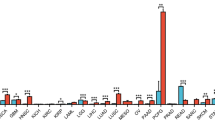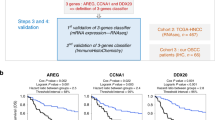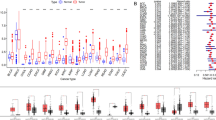Abstract
BORIS is a paralog of a highly conserved, multi-functional chromatin factor CTCF. Unlike CTCF, which has been shown to possess tumor-suppressive properties, BORIS belongs to the “cancer/testis antigen” family normally expressed only in germ cells and aberrantly activated in a variety of tumors. The consequences of BORIS expression, relative abundance of its isoforms, and its role in carcinogenesis have not been completely elucidated. It activates transcription of hTERT and MYC, genes relevant for laryngeal carcinoma progression. In this study, BORIS expression has been analyzed at the transcriptional level by RT-PCR and protein level by semi-quantitative immunohistochemistry in 32 laryngeal squamous cell carcinomas and adjacent non-tumorous tissue. BORIS was detected in 44 % (14/32) laryngeal squamous cell carcinoma samples, while it was detected only in one normal, tumor-adjacent tissue sample. Tree based survival analysis, using the recursive partitioning algorithm mvpart, extracted the ratio of relative abundance of BORIS transcript variants containing exon 7 (BORIS 7+) and those lacking exon 7 (BORIS 7−) as an independent prognostic factor associated with disease relapse during a 5-year follow-up period. Patients having BORIS 7+/BORIS 7− ratio ≥1 had a higher rate of disease relapse than patients with BORIS 7+/BORIS 7− ratio <1. Hazard ratio for that group, based on Cox Proportional Hazard Regression, was 3.53. This is the first study analyzing expression of BORIS protein and transcript variants in laryngeal squamous cell carcinoma relative to its possible prognostic value for recurrence and overall survival.





Similar content being viewed by others
References
Loukinov DI, Pugacheva E, Vatolin S, Pack SD, Moon H, Chernukin I, Mannan P, Larsson E, Kanduri C, Vostrov AA, Cui H, Niemitz EL, Rasko JE, Docquier FM, Kistler M, Breen JJ, Zhuang Z, Quitschke WW, Renkawitz R, Klenova EM, Feinberg AP, Ohlsson R, Morse HC 3rd, Lobanenkov VV (2002) BORIS, a novel male germ-line-specific protein associated with epigenetic reprogramming events, shares the same 11-zinc-finger domain with CTCF, the insulator protein involved in reading imprinting marks in the soma. Proc Natl Acad Sci U S A 99:6806–6811
Vatolin S, Abdullaev Z, Pack SD, Flanagan PT, Custer M, Loukinov DI, Pugacheva E, Hong JA, Morse H 3rd, Schrump DS, Risinger JI, Barrett JC, Lobanenkov VV (2005) Conditional expression of the CTCF-paralogous transcriptional factor BORIS in normal cells results in demethylation and derepression of MAGE-A1 and reactivation of other cancer-testis genes. Cancer Res 65:7751–7762
Hong JA, Kang Y, Abdullaev Z, Flanagan PT, Pack SD, Fischete MR, Adnani MT, Loukinov DI, Vatolin S, Risinger JI, Custer M, Chen GA, Zhao M, Nguyen DM, Barrett JC, Lobanenkov VV, Schrump DS (2005) Reciprocal binding of CTCF and BORIS to the NY-ESO-1 promoter coincides with derepression of this cancer-testis gene in lung cancer cells. Cancer Res 65:7763–7774
Hoffmann MJ, Müller M, Engers R, Schulz WA (2006) Epigenetic control of CTCFL/BORIS and OCT4 expression in urogenital malignancies. Biochem Pharmacol 72:1577–1588
Klenova EM, Morse HC, Ohlsson R, Lobanenkov VV (2002) The novel BORIS + CTCF gene family is uniquely involved in epigenetics of normal biology and cancer. Semin Cancer Biol 12:399–414
Ohlsson R, Renkawitz R, Lobanenkov V (2001) CTCF is a uniquely versatile transcription regulator linked to epigenetics and disease. Trends Genet 17:520–527
Klenova E, Ohlsson R (2005) Poly(ADP-ribosyl)ation and epigenetics: is CTCF PARt of the plot? Cell Cycle 4:96–101
Jelinic P, Stehle J-C, Shaw P (2006) The testis-specific factor CTCFL cooperates with the protein methyltransferase PRMT7 in H19 imprinting control region methylation. PLoS Biol 4:1910–1922
Fiorentino FP, Macaluso M, Miranda F, Montanari M, Russo A, Bagella L, Giordano A (2011) CTCF and BORIS regulate Rb2/p130 gene transcription: a novel mechanism and a new paradigm for understanding the biology of lung cancer. Mol Cancer Res 9:225–233
Filipova GN, Fagerlie S, Klenova EM, Myers C, Dehner Y, Goodwin G, Neiman PE, Collins SJ, Lobanenkov VV (1996) An exceptionally conserved transcriptional repressor, CTCF, employs different combinations of zinc fingers to bind diverged promoter sequences of avian and mammalian c-myc oncogenes. Mol Cell Biol 16:2802–2813
Pugacheva EM, Suzuki T, Pack SD, Kosaka-Suzuki N, Yoon J, Vostrov AA, Barsov E, Strunnikov AV, Morse HC III, Loukinov D, Lobanenkov V (2010) The structural complexity of the human BORIS gene in gametogenesis and cancer. PLoS One 5:e13872
Renaud S, Loukinov D, Alberti L, Vostrov A, Kwon Y-W, Bosman FT, Lobanenkov V, Benhattar J (2011) BORIS/CTCFL-mediated transcriptional regulation of the hTERT telomerase gene in testicular and ovarian tumor cells. Nucleic Acids Res 39:862–873
Ulaner GA, VuTH LT, Hu J-F, Yao X-M, Yang Y, Gorlick R, Meyers P, Healey J, Ladanyi M, Hoffman AR (2003) Loss of imprinting of IGF2 and H19 in osteosarcoma is accompanied by reciprocal methylation changes of a CTCF-binding site. Hum Mol Genet 12:535–549
D’Arcy V, Abdullaev ZK, Pore N, Docquier F, Torrano V, Chernukin I, Smart M, Farrar D, Metodiev M, Fernandez N, Richard C, Delgado DM, Lobanenkov V, Klenova E (2006) The potential of BORIS detected in the leukocytes of breast cancer patients as an early marker of tumorigenesis. Clin Cancer Res 12:5978–5986
Looijenga LH, Hersmus R, Gillis AJ, Pfundt R, Stoop HJ, van Gurp RJ, Veltman J, Beverloo HB, van Drunen E, van Kessel AG, Pera RR, Schneider DT, Summersgill B, Shipley J, McIntyre A, van der Spek P, Schoenmakers E, Oosterhuis JW (2006) Genomic and expression profiling of human spermatocytic seminomas: primary spermatocyte as tumorigenic precursor and DMRT1 as candidate chromosome 9 gene. Cancer Res 66:290–302
Risinger JI, Chandramouli GVR, Maxwell GL, Custer M, Pack S, Loukinov D, Aprelikova O, Litzi T, Schrump DS, Murphy SK, Berchuck A, Lobanenkov V, Barrett JC (2007) Global expression analysis of cancer/testis genes in uterine cancers reveals a high incidence of BORIS expression. Clin Cancer Res 13:1713–1719
Woloszynska-Read A, James SR, Link PA, Yu J, Odunsi K, Karpf AR (2007) DNA methylation-dependent regulation of BORIS/CTCFL expression in ovarian cancer. Cancer Immun 7:21
D’Arcy V, Pore N, Docquier F, Abdullaev ZK, Chernukhin I, Kita GX, Rai S, Smart M, Farrar D, Pack S, Lobanenkov V, Klenova E (2008) BORIS, a paralogue of the transcription factor, CTCF, is aberrantly expressed in breast tumors. Br J Cancer 98:571–579
Kholmanskikh O, Loriot A, Brasseur F, De Plaen E, De Smet C (2008) Expression of BORIS in melanoma: lack of association with MAGE-A1 activation. Int J Cancer 122:777–784
Smith IM, Glazer CA, Mithani SK, Ochs MF, Sun W, Bhan S, Vostrov A, Abdullaev Z, Lobanenkov V, Gray A, Liu C, Chang SS, Ostrow KL, Westra WH, Begum S, Dhara M, Califano J (2009) Coordinated activation of candidate proto-oncogenes and cancer testes antigens via promoter demethylation in head and neck cancer and lung cancer. PLoS One 4:e4961
Smiraglia DJ, Smith LT, Lang JC, Rush LJ, Dai Z, Schuller DE, Plass C (2003) Differential targets of CpG island hypermethylation in primary and metastatic head and neck squamous cell carcinoma (HNSCC). J Med Genet 40:25–33
Schmezer P, Plass C (2008) Epigenetic aspects in carcinomas of the head and neck. HNO 56:594–602
Larynx D et al (2010) In: Edge SB, Byrd DR, Compton CC, Fritz AG, Greene FL, Trotti A (eds) AJCC cancer staging manual, 7th edn. Springer, New York, pp 57–62
Grbeša I, Ivkić M, Pegan B, Gall-Trošelj K (2006) Loss of imprinting and promoter usage of the IGF2 in laryngeal squamous cell carcinoma. Cancer Lett 238:224–229
rpart by Terry M Therneau, Beth Atkinson. R port of rpart by Brian Ripley Rripley@stats.ox.ac.uk>. Some routines from vegan – Jari Oksanen < jari.oksanen@oulu.fi > Extensions and adaptations of rpart to mvpart by Glenn De’ath. (2013) mvpart: Multivariate partitioning. R package version 1.6-1. http://CRAN.R-project.org/package=mvpart. Accessed 15 Jan 2014
R Core Team (2013) R: A language and environment for statistical computing. R Foundation for Statistical Computing, Vienna, Austria. URL http://www.R-project.org/ Accessed 15 Jan 2014
Schumacher M, Holländer N, Schwarzer G, Willi Sauerbrei W (2006) Prognostic factor studies. In: Crowley J, Ankerst DP (eds) Handbook of statistics in clinical oncology, 2nd edn. Chapman & Hall/CRC, Boca Raton, pp 289–333
Liu X (2013) Survival analysis. Wiley, Chichester
Ragin CC, Modugno F, Gollin SM (2007) The epidemiology and risk factors of head and neck cancer: a focus on human papillomavirus. J Dent Res 86:104–114
Pöschl G, Stickel F, Wang XD, Seitz HK (2004) Alcohol and cancer: genetic and nutritional aspects. Proc Nutr Soc 63:65–71
Flatley JE, McNeir K, Balasubramani L, Tidy J, Stuart EL, Young TA, Powers HJ (2009) Folate status and aberrant DNA methylation are associated with HPV infection and cervical pathogenesis. Cancer Epidemiol Biomarkers Prev 18:2782–2789
McCarty KS Jr, Szabo E, Flowers JL, Cox EB, Leight GS, Miller L, Konrath J, Soper JT, Budwit DA, Creasman WT, Seigler HF, McCarty KS Sr (1986) Use of a monoclonal anti-estrogen receptor antibody in the immunohistochemical evaluation of human tumors. Cancer Res 46:4244s–4248s
Rosa-Garrido M, Ceballos L, Alonso-Lecue P, Abraira C, Delgado MD, Gandarillas A (2012) A cell cycle role for the epigenetic factor CTCF-L/BORIS. PLoS One 7:e39371
Grbesa I, Marinkovic M, Ivkic M, Kruslin B, Novak-Kujundzic R, Pegan B, Bogdanovic O, Bedekovic V, Gall-Troselj K (2008) Loss of imprinting of IGF2 and H19, loss of heterozygosity of IGF2R and CTCF, and helicobacter pylori infection in laryngeal squamous cell carcinoma. J Mol Med (Berl) 86:1057–1066
Hogarth C, Itman C, Jans DA, Loveland KL (2005) Regulated nucleocytoplasmic transport in spermatogenesis: a driver of cellular differentiation? BioEssays 27:1011–1025
Nguyen P, Bar-Sela G, Sun L, Bisht KS, Cui H, Kohn E, Feinberg AP, Gius D (2008) BAT3 and SET1A form a complex with CTCFL/BORIS to modulate H3K4 histone dimethylation and gene expression. Mol Cell Biol 28:6720–6729
Ozaki T, Hanaoka E, Naka M, Nakagawara A, Sakiyama S (1999) Cloning and characterization of rat BAT3 cDNA. DNA Cell Biol 18:503–512
Manchen ST, Hubberstey AV (2001) Human Scythe contains a functional nuclear localization sequence and remains in the nucleus during staurosporine-induced apoptosis. Biochem Biophys Res Commun 287:1075–1082
Tsukahara T, Kimura S, Ichimiya S, Torigoe T, Kawaguchi S, Wada T, Yamashita T, Sato N (2009) Scythe/BAT3 regulates apoptotic cell death induced by papillomavirus binding factor in human osteosarcoma. Cancer Sci 100:47–53
Ehrlich M (2002) DNA methylation in cancer: too much, but also too little. Oncogene 21:5400–5413
Renaud S, Pugacheva EM, Delgado MD, Braunschweig R, Abdullaev Z, Loukinov D, Benhattar J, Lobanenkov V (2007) Expression of the CTCF-paralogous cancer-testis gene, brother of the regulator of imprinted sites (BORIS), is regulated by three alternative promoters modulated by CpG methylation and by CTCF and p53 transcription factors. Nucleic Acids Res 35:7372–7388
Hines WC, Bazarov AV, Mukhopadhyay R, Yaswen P (2010) BORIS (CTCFL) is not expressed in most human breast cell lines and high grade breast carcinomas. PLoS One 5:e9738
Acknowledgments
This work was funded by grants 098-0982464-2511 and 108-1081870-1884 from the Ministry of Science, Education and Sport, Republic of Croatia.
Author information
Authors and Affiliations
Corresponding author
Rights and permissions
About this article
Cite this article
Novak Kujundžić, R., Grbeša, I., Ivkić, M. et al. Possible Prognostic Value of BORIS Transcript Variants Ratio in Laryngeal Squamous Cell Carcinomas – a Pilot Study. Pathol. Oncol. Res. 20, 687–695 (2014). https://doi.org/10.1007/s12253-014-9749-y
Received:
Accepted:
Published:
Issue Date:
DOI: https://doi.org/10.1007/s12253-014-9749-y




